In 2014 the City of Rome celebrated the Bimillennial (2000th) anniversary of the death of the Emperor Augustus. He died on August (of course) 19th, 14 AD, after ruling over Rome for 41 years as the first Imperial Emperor.
The side-by-side Houses of Augustus and his wife Livia (rarely accessible to the public) on the Palatine Hill were open by advance reservation.
Every night from April to November, thousands of people were entertained with a video and light show projected onto the ruins of the Augustus Forum along the via dei Fori Imperiale.
The show was created by the Italian historian and television host, Piero Angela and astrophysicist and science writer Paco Lanciano.
The Ara Pacis museum (Temple of Peace inaugurated by Augustus in 9BC) hosted an exhibition dedicated to Rome’s 1st Emperor.
The subterranean vaulted rooms of the Villa of Livia at Prima Porta (about an hour from Central Rome by Metro) were open, but the best parts of the Villa were removed to the Vatican Museums or Palazzo Massimo National Roman Museum near the Termini train station.
However, quite a few Augustinian antiquities excluded from the celebration.
The Porta d’Octavia in the Jewish Ghetto (named for Octavia, the sister of Augustus) was still hiding under scaffold. It was being restored, but wasn’t ready for her brother’s anniversary. The Teatro Marcello (dedicated to the son of Octavia and nephew of Augustus) was also quiet for the anniversary.
Plans to include the 2009 discovery of the grand marble Augustan Stables off the via Giulia were scratched. After 5 years the archeological dig ran out of funds and the site is currently being reburied till a later time.
But the most conspicuous missing piece of the Commemoration was the Mausoleum of Augustus. It’s been in ruins since 1937.
These days the Imperial tomb is more of a dead monument than a monument of the dead.
 Built in 28 BC, the Mausoleum was a “who’s who’ of ancient Rome.
Built in 28 BC, the Mausoleum was a “who’s who’ of ancient Rome.
The list of interred included Augustus, his mother Atia Balba, his 3rd wife Livia, his sister Octavia and her son Marcellus, the Emperor Tiberius and Drusus Germanicus (Livia’s children from a previous marriage), Gaius, Lucius and Marcus Vipsanius Postumus (grandchildren of Augustus from his daughter Julia) and Marcus Agrippa (architect, soldier, son-in-law and best friend).
In later years the Tomb became the resting place of the Emperor Caligula, the Emperor Claudius and his son Britannicus, the Emperor Nerva, Poppea Sabina (wife of the Emperor Nero) and Julia Domna (wife of the Emperor Septimius Severus and mother of the Emperor Caracalla). The list goes on.
Once the Romans had seen the Tomb of Mausolus in Halicarnassus (Bodrum, Turkey), the term ‘Mausolea’ was adopted to describe all of their above ground tombs of Rome. Although the Mausolea of Halicarnassus was square, the Romans preferred the ‘rotunda’ shaped monument and from the 1st century BC these round mausoleums decorated the Appian Way leading into the city. Only the Emperors and their families were allowed burial rights inside the walls of Rome.
The Mausoleum Rotunda of Augustus was a marvel to behold, 295’ in diameter and 137’ tall and capped with cypress trees and a 15’ bronze replica of the Emperor.
As legend goes, when Rome was sacked in 410 by Alaric and the Visigoths, they broke into the Mausoleum and stole the gold funerary urns, dumping out the ashes. In one act of destruction, over 250 years of Rome’s royalty literally went up in a puff of smoke.
The grand monument was built of brick and covered with travertine marble. Augustus is remembered for the words, ‘Marmoream se relinquere, quam latericiam accepisset’ (I found a city of brick and left a city of marble). How ironic that his tomb was found in marble and left as a ruin of brick.
Over the years the travertine was removed to build the new churches of Rome. In 1519, Pope Leo X removed what was left of the marble and used it to pave the via Ripetta.
The over 45’ obelisks that once flanked both sides of the Mausoleum entrance ended up in the Piazza dell’Esquilino near the Basilica of Santa Maria Maggiore and the Quirinale Hill next to the ancient statues of the Dioscuri outside of the Quirinale Palace.
The afterlife of the Mausoleum was mostly filled with disrespect but there were a few brief moments of joy.
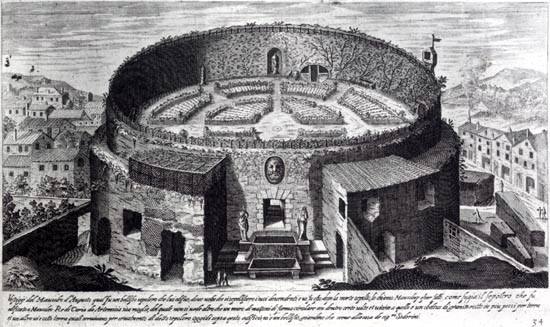 In the 12th century during the wars between the Guelphs (Pope supporters) and Ghibellines (Holy Roman Emperor supporters) the Mausoleum became the city fortress for the Pope supporting (Guelph) Colonna family till it was blown up in 1167 by forces led by the Ghibelline Orsini family of Rome and the Counts of Tusculum (about 25km southeast of Rome).
In the 12th century during the wars between the Guelphs (Pope supporters) and Ghibellines (Holy Roman Emperor supporters) the Mausoleum became the city fortress for the Pope supporting (Guelph) Colonna family till it was blown up in 1167 by forces led by the Ghibelline Orsini family of Rome and the Counts of Tusculum (about 25km southeast of Rome).
In 1546, Pope Paul III sold the Augustus Mausoleum to the Soderini family, who after digging around for anything valuable, turned it into a palazzo and sculpture garden. This engraving to the left is by Étiene Dupérac of the gardens in from 1575.
 In 1780, the property was sold off to the Marquis Portuguese, Vincenzo Hands Correa who turned it into the open air Anfiteatro Corea, a place for concerts, firework displays, animal hunts and bullfights and a hot air balloon ascension in 1788. However, in 1802, Pope Pius VIII took the Mausoleum back into the arms of the Vatican. He discontinued the animal hunts and fireworks but the carnivals and family style extravaganzas continued.
In 1780, the property was sold off to the Marquis Portuguese, Vincenzo Hands Correa who turned it into the open air Anfiteatro Corea, a place for concerts, firework displays, animal hunts and bullfights and a hot air balloon ascension in 1788. However, in 1802, Pope Pius VIII took the Mausoleum back into the arms of the Vatican. He discontinued the animal hunts and fireworks but the carnivals and family style extravaganzas continued.
After the Italian Unification in 1870, the Vatican sold the Anfiteatro Corea (Mausoleum) to a Count Telfener who covered it with a roof, built seating for over 2,000 and staged concerts, plays, horse shows. In 1878, he changed the name to the Amphiteatro Umberto I (in honor of the new King of Italy).
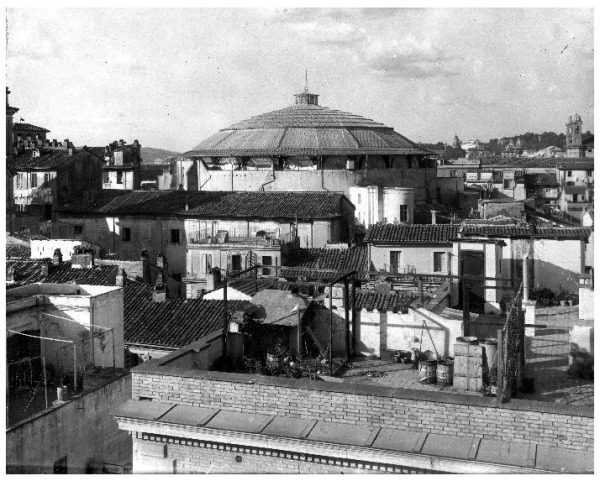 In 1907 the Anfiteatro Corea/Amfiteatro Umberto I was renovated into the 3,500 seat concert hall known as the Augusteo Concert Hall or ‘The Augosteo’, the home of the well known Academia Nazionale di Santa Cecilia Rome Concert Orchestra, one of the oldest music institutions in the world.
In 1907 the Anfiteatro Corea/Amfiteatro Umberto I was renovated into the 3,500 seat concert hall known as the Augusteo Concert Hall or ‘The Augosteo’, the home of the well known Academia Nazionale di Santa Cecilia Rome Concert Orchestra, one of the oldest music institutions in the world.
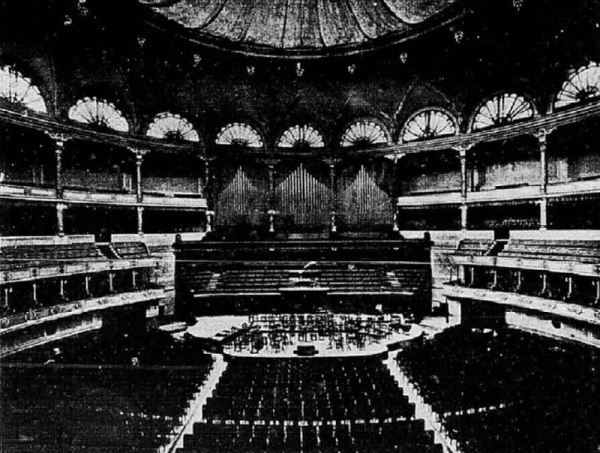 All was going well for the old mausoleum. The wonderful Art Nouveau ‘Augosteo’ theater was a big success and beloved by the Romans. But then it all ended in 1937 when Benito Mussolini made plans to celebrate his Bimillennial (2000th) anniversary of the birth of the Emperor Augustus.
All was going well for the old mausoleum. The wonderful Art Nouveau ‘Augosteo’ theater was a big success and beloved by the Romans. But then it all ended in 1937 when Benito Mussolini made plans to celebrate his Bimillennial (2000th) anniversary of the birth of the Emperor Augustus.
The plans included tearing down the neighborhood around the Muasoleum and constructing the grand Piazza Augosto Imperatore.
A museum was created to hold the 9 BC Ara Pacis Altar dedicated to Pax, the Roman Goddess of peace after Augustus came back from the wars in Hispania and Gaul. The altar was moved to the newly renovated Piazza Augusto Imperatore in 1938 as part of Mussolini’s plans. Here is a 1938 newsreel of the consecration of the Ara Pacis by Mussolini.
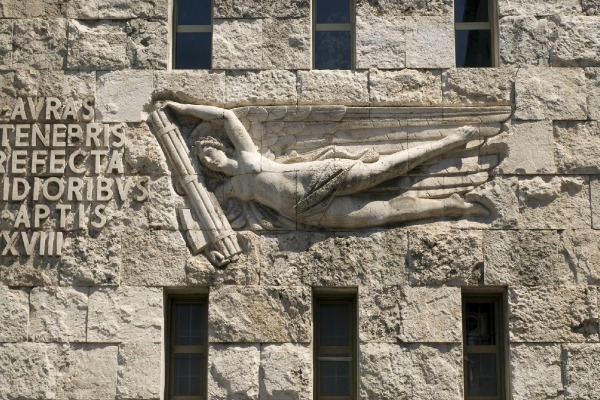 The Istituto Nazionale Fascista Previdenza building built at the same time still stands in the Piazza and still proudly displays the Fascist façade of flying Victories carrying a bundle of fasces (tied rods).
The Istituto Nazionale Fascista Previdenza building built at the same time still stands in the Piazza and still proudly displays the Fascist façade of flying Victories carrying a bundle of fasces (tied rods).
The Mausoleum was going to be his showpiece of the new Piazza. Mussolini thought of himself as the second coming of the emperor Augustus who would create the new Italy as a World power.
 The ‘Augosteo’ was destroyed. Mussolini stripped the building of everything not related to the ancient mausoleum. He planted cypress trees around the base and built a squat round tower over the (presumed) spot where the funerary ashes of Augustus once resided.
The ‘Augosteo’ was destroyed. Mussolini stripped the building of everything not related to the ancient mausoleum. He planted cypress trees around the base and built a squat round tower over the (presumed) spot where the funerary ashes of Augustus once resided.
By 1939, Italy was at War and most of the municipal projects screeched to a halt. This was literally the end of the Mausoleum of Augustus.
After the war, it became a shelter for the Roman homeless and vagrant gypsies. Eventually it was closed off to the public. A high fence now surrounds the monument keeping out everything but stray cats and smaller animals.
Hopes were rekindled around 1999 with plans to renovate and restore the Mausoleum and the Ara Pacis.
In 2006, the very modern museum, designed by American architect Richard Meier made the Mausoleum seem even more neglected.
When the Ara Pacis Museum was in the design phase there were talks to include the entire Piazza Augusto Imperatore, including the restoration of the Mausoleum but the Italians have a very difficult time agreeing to anything.
Decisions in Italy are made by committee. There always seem to be too many people involved. More often than not, nothing happens.
The Meier Ara Pacis became an instant flop.
The New York Times called it as clueless as it’s Fascist predecessors who built the surrounding Piazza, calling the building “a contemporary expression of what can happen when an architect fetishizes his own style out of a sense of self-aggrandizement. Absurdly overscale, it seems indifferent to the naked beauty of the dense and richly textured city around it.”
Most Romans agreed. There were even Mayoral campaign promises to tear it down, but over eight years later it’s still there. Romans are learning to accept it.
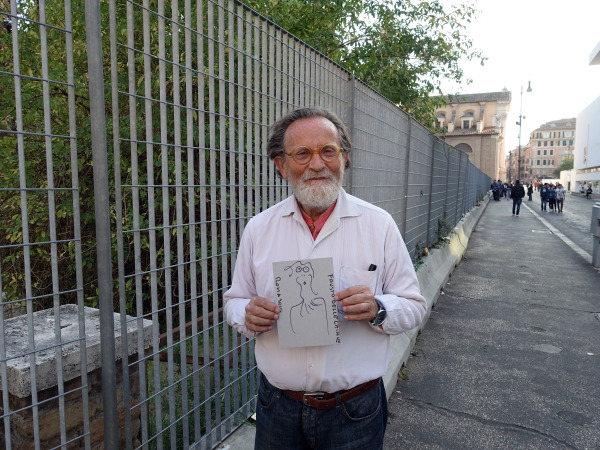 These days the unofficial caretaker of the great Augustus Mausoleum has been one Fausto Delle Chiaie who shares the space with stray cats and weeds.
These days the unofficial caretaker of the great Augustus Mausoleum has been one Fausto Delle Chiaie who shares the space with stray cats and weeds.
For the past 25 years, Fausto has been collecting strange items from garbage cans and streets and creating small art tributes to the Divine Augustus.
With each installation he tells you how many pieces are in the show. At the end of the view/meditation, you are allowed to leave your own tribute to Fausto and the Divine Augusto.
Fausto says Augustus built our city. He is still watching over us. He should not be forgotten.
Italy has more UNESCO Heritage sites than any other country in the world (50 in all). Although this should be a number of great pride, it has become a great financial burden, especially when all the sites petition for more funding all at the same time.
There is an Italian joke that roughly translates to: 60% of world’s classical heritage is in Italy. The rest is world’s classical heritage is safe.
Until 2014, Fausto was possibly the only one who kept the spirit of the Augustus Mausoleum alive.
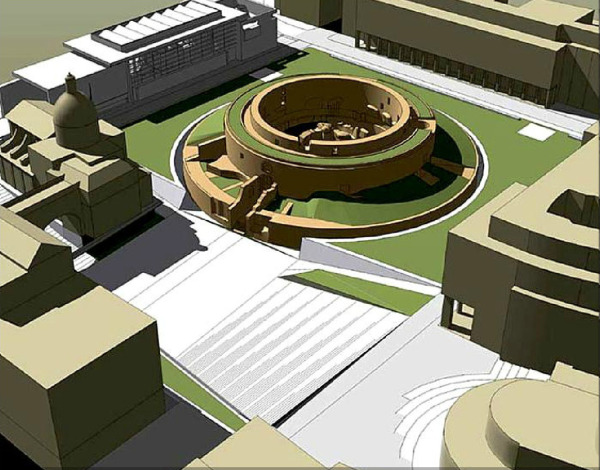 Then in early 2014 plans were once again submitted for restoring the Mausoleum and recreating a beautiful Piazza Augosto Imperiale.
Then in early 2014 plans were once again submitted for restoring the Mausoleum and recreating a beautiful Piazza Augosto Imperiale.
The Italian Government allocated million euros to clean up and re-open the site. The City of Rome has kicked in another million euros.
Aside from the Mausoleum, the city has also allocated an additional million euros to create a pedestrian environment around the Piazza Augosto Imperatore.
Although it might seem like a lot of money, in archeological terms it’s not much at all. Another million is needed and funding will need to come private donors.
Italy has reached out to several private donors for funding to restore the ancient monuments. These are not just Italian properties, they are part of the world’s heritage and should be protected and loved by all nations.
On October 19, 2014 The CBS news show ’60 Minutes’ produced this piece on how fashionable houses are saving history. They did a very good job of explaining the issue.
In 2011, Yuzo Yagi, the Japanese clothing mogul who owns Moncler, Barbour and other European clothing manufacturers donated million for restoration to the Piramide of Gaius Cestius. In 2013, Yagi donated another million.
In 2011, Diego Della Valle, the CEO of Tod’s leather goods gave million to the restoration of the Colosseum although the Italian bureaucratic red tape held up the work for 3 years.
The Fendi fashion house gave million euros to clean up the Trevi Fountain. They also paid for a walkway for tourists to get in and look at the fountain (mostly under scaffold).
Luxury jewelry company,Bulgari also announced they will give money to restore the Spanish Steps.
There were rumors floating around that a Saudi prince was interested in donating funds to the restoration of the Mausoleum of Augustus but so far, it’s just been a rumor.
2017 update:
The Piazza Augosto Imperatore project is underway. The 10 million euro project is scheduled to be completed in 2019. Telecom Italia (TIM) has donated million euros to the restoration project. The other million is through public funds from the City of Rome.
The area has been cleaned out and scaffolding is erected. When it is completed there will be a roof over the top and an adjoining museum. 2019 is only 2 years away. We’re excited.
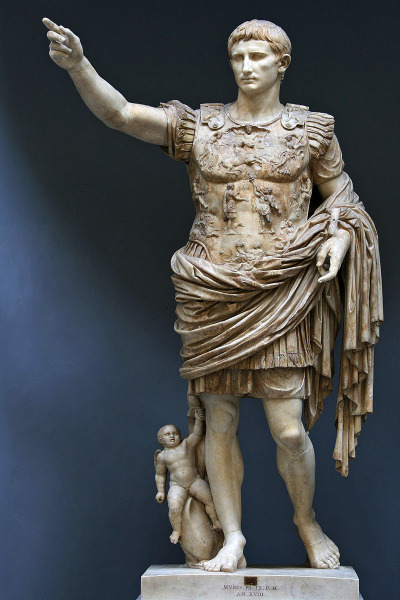
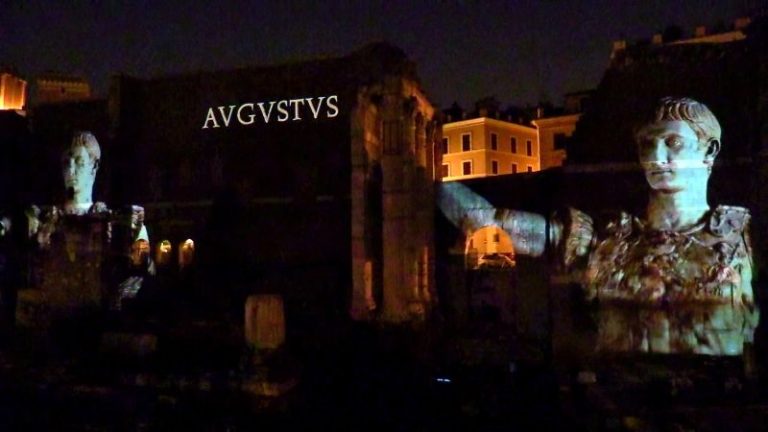
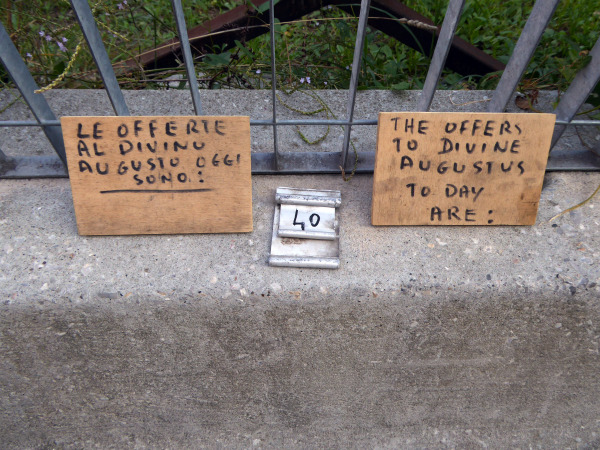

You must be logged in to post a comment.